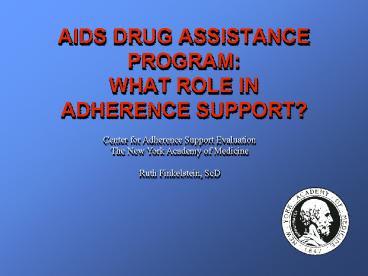AIDS DRUG ASSISTANCE PROGRAM: WHAT ROLE IN ADHERENCE SUPPORT - PowerPoint PPT Presentation
1 / 19
Title:
AIDS DRUG ASSISTANCE PROGRAM: WHAT ROLE IN ADHERENCE SUPPORT
Description:
AIDS DRUG ASSISTANCE PROGRAM: WHAT ROLE IN. ADHERENCE SUPPORT? ... may achieve acceptable adherence with appropriate assistance and support. ... – PowerPoint PPT presentation
Number of Views:17
Avg rating:3.0/5.0
Title: AIDS DRUG ASSISTANCE PROGRAM: WHAT ROLE IN ADHERENCE SUPPORT
1
AIDS DRUG ASSISTANCE PROGRAM WHAT ROLE IN
ADHERENCE SUPPORT?
Center for Adherence Support Evaluation The New
York Academy of Medicine Ruth Finkelstein, ScD
2
WHY SHOULD ADAP CARE ABOUT ADHERENCE?
- Drug effectiveness is partly dependent on
adherence. - The reduced effectiveness of HAART associated
with poor adherence is partly due to the
development of drug resistance. - Resistance can occur to a class of drugs not just
an individual drug.
3
CONSEQUENCES OF RESISTANCE
- Clinical
- Public Health
- Cost
4
CONSEQUENCES OF RESISTANCE
Clinical Poor viral suppression is associated
with increases in morbidity and mortality.
5
CONSEQUENCES OF RESISTANCE
Public Health Concerns
- In a national survey of 1,080 HIV patients, among
those with gt500 copies HIV RNA/ml, 78 had drug -
resistant virus. - Even among newly - infected, treatment - naïve
patients, one in five had resistant virus --
suggesting the transmission of drug resistant
virus.
6
CONSEQUENCES OF RESISTANCE
Cost
- Resistance to classes of drugs necessitates
prescription of expensive and less effective
salvage therapies (highly complex regimens with
multiple therapeutic agents). - Poor clinical outcomes result in increases in
costly inpatient utilization.
7
APPROACHES TO IMPROVE ADHERENCE
NOT Recommended
- Prescribe treatment only for adherent patients.
- Major Problems
- Dont know who will be adherent.
- In the absence of such knowledge, decisions are
based on negative perceptions/assumptions.
8
APPROACHES TO IMPROVE ADHERENCE
Recommended
- Multi-faceted approaches delivered in combination
considering patient, physicians, other health
care providers, regimen and system
characteristics. - Patients who face substantial barriers may
achieve acceptable adherence with appropriate
assistance and support.
9
MULTI -FACETED APPROACHES TO IMPROVE ADHERENCE
- System
- Regimen
- Provider
- Patient
10
SYSTEM APPROACHES
- Based on identified adherence barriers,
- system interventions should seek to reduce
- barriers associated with healthcare and
- treatment access
- Eliminate interruptions in insurance coverage.
- Monitor gaps in refilling prescriptions and
- follow-up in real time.
- Minimize prescription refilling burden.
- Facilitate appointment making and keeping.
- Reduce waiting time for appointments and
- clinic visits.
- Provide or reimburse for transportation and
child care. - Eliminate or reduce cost associated with
medications. - Offer DOT and modified DOT options.
11
REGIMEN APPROACHES
Interventions addressing regimen issues should
- Prescribe regimen consistent with patient daily
routine. - Regimen tailoring and development of specific
- treatment plans.
- Simplify numbers of doses when possible.
- Evidence for adherence benefit of regimens
without - mid-day dose (once per day dosing has
equivocal - results complex issues).
- Treat side effects immediately and aggressively.
- Pill-swallowing practice (for pediatric
patients). - Pill boxes.
- Reminder tools and systems of recording
- medication-related behaviors.
12
PROVIDER APPROACHES
- Provider/patient relationship has a strong
- potential to influence patient adherence.
- Interventions should target providers
- through
- Skills Training
- Professionals Guidance
- Implementation of multi-disciplinary
- teams or referral networks
13
PROVIDER APPROACHES
- Interventions developed with providers in
- mind should seek to encourage the following
- behaviors
- Prescribe simpler regimens.
- Enhance communication skills
- (especially listening).
- Assess patients potential adherence barriers.
- Individualize written instructions.
- Use pictorial cues, reminders, instructions
- when language or literacy level requires.
- Screen for depression and substance use.
14
PROVIDER APPROACHES
- Educate and motivate.
- Stabilize living situation when possible.
- Provide adherence tools beeper, pill boxes.
- Involve patients in treatment choices.
- Enlist family members, friends and/or parents.
- Aggressively anticipate and manage side
effects. - Evidence about provider trust suggests that
patients - convey different information regarding
adherence - problems to non-physicians and computers.
- Consider multiple methods of adherence
assessment. - Strong anecdotal/program level evidence about
- peer based programs.
- Both pharmacists and nurses are associated with
- effectiveness.
15
PATIENT APPROACHES
- Patient centered approaches to
- adherence should be
- a combination of multiple
- interventions to address a range of
- adherence barriers
- delivered consistently over time
- linked to clinical care.
16
PATIENT APPROACHES
- Certain barriers have been consistently
- associated with poor adherence
- Untreated mental health issues
- (particularly depression)
- Current substance use (crack and alcohol)
- History of poor adherence
- Medication side-effects
17
PATIENT APPROACHES
- Methods to measure adherence
- include
- Self report
- MEMS caps
- Prescription refill monitoring
- Pill counts
- Physician/nurse assessment
- Plasma drug testing
18
PATIENT APPROACHES
- Educational/informational strategies
- should be culturally specific and
- tailored to the individual.
- Materials usually include
- Visual aids
- Color-coded medication schedules
- Dosing diagrams
19
PATIENT APPROACHES
- Behavioral strategies are designed to
- influence patient behavior through
- Incentives
- Reminders
- Skills training
- Patient motivation and enhanced
- self efficacy






























